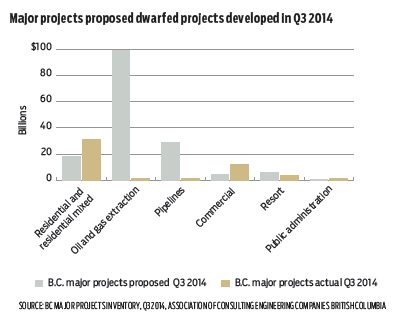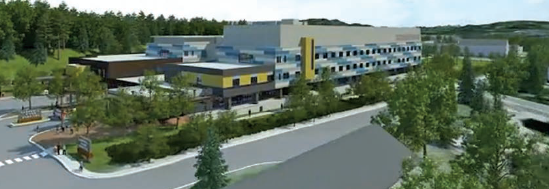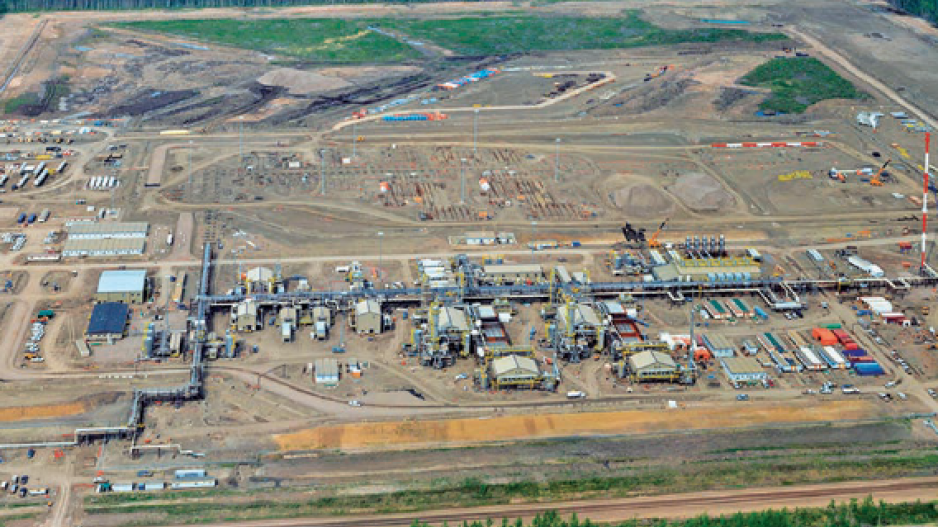At $376.8 billion, the latest British Columbia major projects inventory tallied another record high in 2014’s third quarter, but “proposed” projects accounted for more than two-thirds of the major projects list prepared by the Association of Consulting Engineering Companies British Columbia (ACEC-BC). The report shows that the real construction action is overwhelmingly in new homes and residential mixed-use projects in Metro Vancouver and the Fraser Valley.
Proposed projects, many related to the liquefied natural gas (LNG) industry, rose to a record high of $269.5 billion, up 34.6% from a year earlier and 14% higher than in 2014’s second quarter.
And the number of projects put on hold jumped 33.8% compared with the same period in 2013 as $23.7 billion in construction plans, not all of them resource-related, were mothballed.
The latest project in the “proposed” category is a $10 billion bitumen refinery by Pacific Future Energy Corp. near Prince Rupert.
“We were not too surprised at the number of proposed projects, as this has been a trend for a number of quarters,” said Keith Sashaw, ACEC-BC president and CEO.
The number of projects put on hold will likely increase this year, Sashaw said, due to the recent drop in energy prices and the “somewhat uncertain nature of the global economic picture.”
The major inventory listing reports that $27.2 billion in mining projects were put on hold in the third quarter of 2014, up 47.4% from a year earlier.
Yet engineering companies overall “are confident in the general outlook for major projects in B.C., recognizing that there are several factors out there that can cloud the picture,” Sashaw said.
Notable projects shelved include the $800 million Phase 2 Cabin Gas Plant expansion by Encana Corp. in northeast B.C., Vancity’s $650 million Dockside Green residential mixed-use development in Victoria and North Coast Wind Energy Corp.’s $400 million Banks Island North Wind Energy Project near Prince Rupert.
Weaker market conditions for natural gas may have prompted Encana to delay development of the second phase of the Cabin gas project, according to ACEC-BC.
The northwest coast of B.C. led the entire province in major projects in the third quarter, with construction valued at $148.3 billion, but $131.6 billion of this is listed as proposed. Proposals include the LNG Canada project in Kitimat, valued at $10 billion, and the Woodside Energy LNG project in Prince Rupert, also estimated at $10 billion.
On a year-over-year basis, the total value of major projects in the oil and gas extraction sector, including under construction and proposed, was 142.4% higher at $100.6 billion, while manufacturing projects were up 46.9%.

For the actual $81.6 billion in construction starts in the third quarter, the action is mostly in residential and residential mixed-use projects. Such projects accounted for $30.8 billion in construction starts in the third quarter of 2014, or about 40% of all B.C. construction starts.
Provincewide, the $15.6 billion in residential construction starts accounted for more than twice as much spending in the third quarter of 2014 than manufacturing, pipelines, oil and gas extraction and mining projects combined.
As of the third quarter of 2014, $41.1 billion worth of construction had started in the Lower Mainland region, accounting for half of all starts in the province, and primarily represented by residential and residential mixed-use projects.
The two largest projects started in the third quarter were the $606.2 million North Island Hospitals Project by the Vancouver Island Health Authority, which will include new hospitals built simultaneously in Campbell River and Comox, and FortisBC’s $400 million Tilbury LNG facility expansion in Delta. •
Innovation cuts cost of B.C.’s biggest construction project

The 95-bed Campbell River and 153-bed Comox Valley hospitals form the $606.2 million North Island Hospitals Project, the largest construction project started in B.C. in 2014’s third quarter | Image: Vancouver Island Health Authority
An advanced method of “column-hung” concrete slab construction will likely trim about 20% of the cost of British Columbia’s biggest project, according to Tom Sparrow, manager of the North Island Hospitals Project for the Vancouver Island Health Authority (VIHA).




